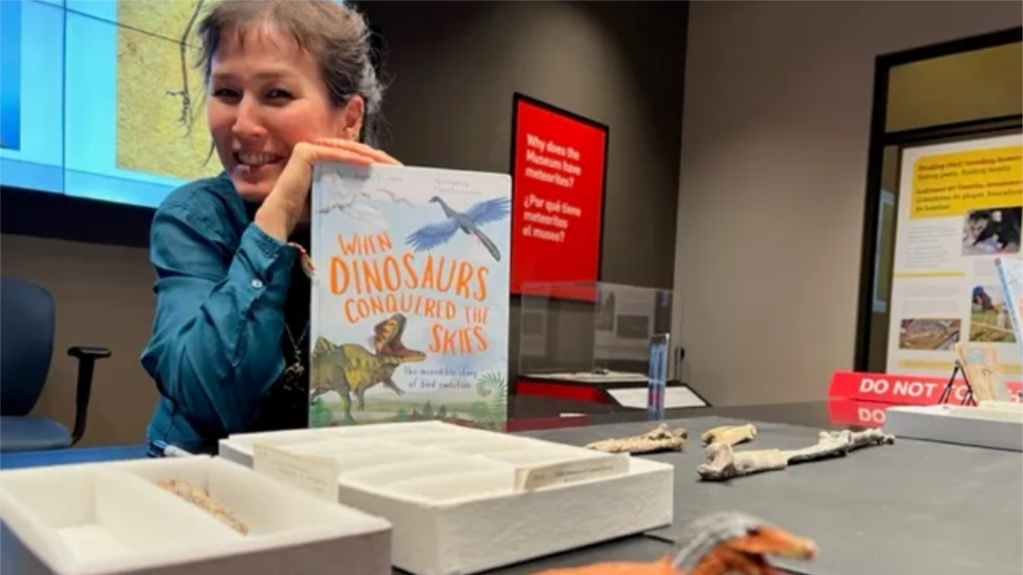If you love to watch birds, you can call yourself a bird watcher, or you can call yourself something even more interesting — a dinosaur watcher!
A new picture book called When Dinosaurs Conquered the Skies: The Incredible Story of Bird Evolution explains the scientific idea that birds are dinosaurs.
The writer Jingmai O’Connor describes herself on Instagram as a “dead bird nerd.” With her PhD, she works at the Chicago Field Museum as an expert on the evolution of birds and flying dinosaurs.
O’Connor says people may know that birds are little dinosaurs. But they might not connect that fact to the birds they see.
“Now, people are more and more aware of the fact that birds are living dinosaurs. But despite that, people don’t really make the connection.”
One purpose of her book, she said, is to make that connection. O’Connor also wants people to see birds as she does – as fascinating flying dinosaurs.
“So, I really hope that people will really truly start to see birds as little dinosaurs and…become more fascinated with birds by understanding that they are part of this, you know, fascinating ancient lineage.”
With its clear explanations and colorful pictures by Maria Brzozowska, When Dinosaurs Conquered the Skies can help anyone of any age understand this complex bird evolution.
“When people think of dinosaurs, they think of triceratops, stegosaurus, or, you know, apatosaurus. And if you think about those dinosaurs, they are not particularly bird-like, right?”
O’Connor explains that everyone knows common characteristics of birds. For example, birds have feathers. They use their own body heat to warm their eggs. Birds often lay colored eggs. O’Connor said these bird characteristics evolved from dinosaurs most closely related to them. She added that you need to look at the evolution of one lineage of dinosaurs – therapods.
“So, you really have to look at the evolution of one lineage of dinosaurs – that is the therapod lineage. So, that includes velociraptor or t-rex. And as you look at the evolution of this group, you’ll see the appearance of bird characteristics until you eventually reach a point where, you’re like, that dinosaur is now a bird.”
What is science?
In her book, O’Connor also talks about the larger idea of science – namely the importance of making mistakes. Each mistake, she said, leads us closer to the truth.
“Science is essentially a series of mistakes. And every mistake, you know, informs us a little bit more and gives us a little bit more information. But pretty much everything that we think is ‘truth’ right now is probably at least partly wrong. You know, there is so much we don’t know. But mistakes are part of the process.”
Early influences
O’Connor is a Chinese-Irish American who grew up in Pasadena, California. She did not always want to study the remains of ancient living things. She began studying geology, like her mother.
“But in my case, my mother went back to school to do her Ph.D. when I was around 10 years old. And so, she had four kids. … So, she would take us with her to the laboratory, but also into the field, which means going out to collect samples or specimens. So, I fell in love with geology."
Then in college, O’Connor took a class and discovered a different but related field of study. The class was paleontology, the study of the bones and remains of ancient living things. Her teacher was a paleontologist.
“But then my first year in college, I took a class by a paleontologist named Dr. Donald Prothero and he was such a wonderful teacher … that I got hooked!"
In fact, O’Connor said she did not always like birds. But with further study she started to feel differently.
“And then I started, you know, studying birds. I really found out they’re such fascinating animals. They’re reptiles! But they have evolved to be so different from what we think of as a reptile that actually even scientists didn’t realize they were reptiles until fairly recently.”
Sustainability – the larger goal
However, O’Connor had a larger goal in mind when she wrote her book. She said she hopes to leave the reader with a desire to create a more sustainable lifestyle – one that is good for the environment.
“Through having greater respect for the living animals around us, I hope that people start to think more about how they impact the environment through their actions, so that we can all move towards a more sustainable future.”
I’m Anna Matteo.

